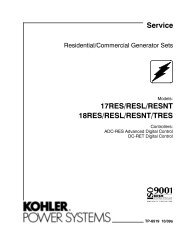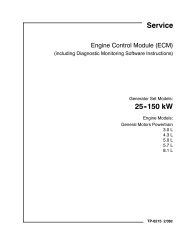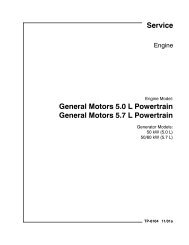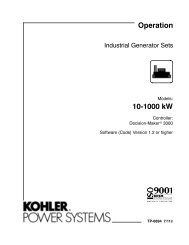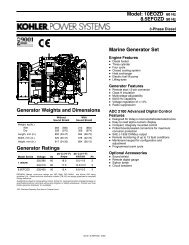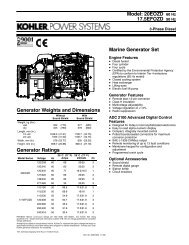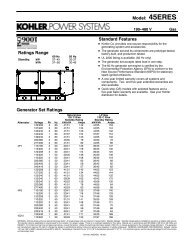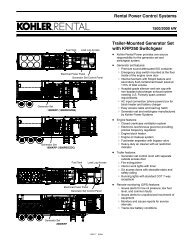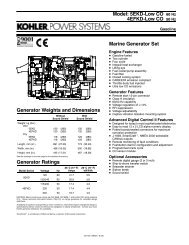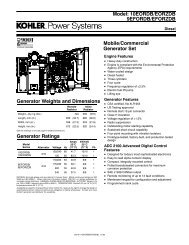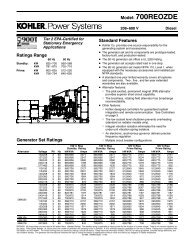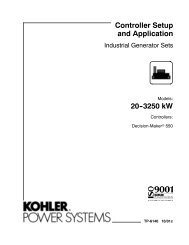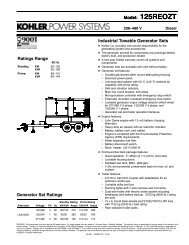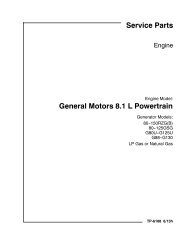Service Manual, General Motors 4.3L Engine (TP ... - Kohler Power
Service Manual, General Motors 4.3L Engine (TP ... - Kohler Power
Service Manual, General Motors 4.3L Engine (TP ... - Kohler Power
Create successful ePaper yourself
Turn your PDF publications into a flip-book with our unique Google optimized e-Paper software.
<strong>Engine</strong> Marine/Industrial <strong>4.3L</strong> 6-11<br />
Base <strong>Engine</strong> Misfire Diagnosis (cont’d)<br />
Checks Action<br />
Abnormal Internal <strong>Engine</strong> Noises<br />
No Abnormal Internal <strong>Engine</strong> Noise<br />
1. Start the engine and determine if the noise is timed to the engine camshaft speed or<br />
the crankshaft speed.<br />
2. Using a timing light, two knocks per flash is the crankshaft speed and one knock<br />
per flash is the engine camshaft speed.<br />
3. If the noise is timed to the engine camshaft speed, inspect the following:<br />
Missing or loose valve train components<br />
Worn or loose valve rocker arms<br />
Worn or bent valve pushrods<br />
Faulty valve springs<br />
Bent or burnt valves<br />
Worn engine camshaft lobes<br />
Worn or damaged camshaft timing chain and/or sprockets<br />
Important: A slight COLD knock or piston slapping noise could be considered normal<br />
if not present after the engine has reached normal operating temperatures.<br />
If the knock is timed to the crankshaft speed, inspect the following:<br />
Worn crankshaft or connecting rod bearings<br />
Piston ro cylinder damage<br />
Worn piston or piston pin<br />
Faulty connecting rod<br />
Excessive carbon build-up on the top of the piston<br />
1. Inspect for a worn or improperly installed camshaft timing chain and/or sprockets.<br />
2. Remove the valve rocker arm cover on the side of the engine with the cylinder that<br />
is misfiring.<br />
3. Inspect for the following:<br />
Loose valve rocker arm studs<br />
Bent valve push rods<br />
Faulty valve springs<br />
Faulty valve lifters (bleeding down)<br />
Worn or improperly seated valves<br />
Worn engine camshaft lobes<br />
<strong>Engine</strong> Compression Test<br />
1. Disconnect the positive ignition coil wire plug from<br />
ignition coil.<br />
2. Disconnect the fuel injector electrical connector.<br />
3. Remove all the spark plugs.<br />
4. Block the throttle plate wide open.<br />
5. Charge the battery if the battery is not fully<br />
charged.<br />
6. Start with the compression gauge at zero. Then<br />
crank the engine through four compression<br />
strokes (four puffs).<br />
7. Make the compression check the same for each<br />
cylinder. Record the reading.<br />
The minimum compression in any one cylinder<br />
should not be less than 70 percent of the highest<br />
cylinder. No cylinder should read less than 690<br />
kPa (100 psi). For example, if the highest<br />
pressure in any one cylinder is 1035 kPa (150<br />
psi), the lowest allowable pressure for any other<br />
cylinder would be 725 kPa (105 psi).<br />
(1035 x 70% = 725) (150 x 70% = 105).<br />
8. If some cylinders have low compression, inject<br />
approximately 15 ml (one tablespoon) of engine<br />
oil into the combustion chamber through the spark<br />
plug<br />
hole.<br />
• Normal - Compression builds up quickly and<br />
evenly to the specified compression for each<br />
cylinder.<br />
• Piston Rings Leaking - Compression is low on the<br />
first stroke. Then compression builds up with the<br />
following strokes but does not reach normal.<br />
Compression improves considerably when you<br />
add oil.<br />
• Valves Leaking - Compression is low on the first<br />
stroke. Compression usually does not build up on<br />
the following strokes. Compression does not<br />
improve much when you add oil.<br />
• If two adjacent cylinders have lower than normal<br />
compression, and injecting oil into the cylinders<br />
does not increase the compression, the cause<br />
may be a head gasket leaking between the two<br />
cylinders.<br />
9. Install the removed parts.<br />
10. Connect the disconnected components.<br />
2000 Marine/Industrial



